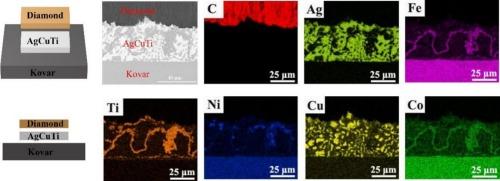钎焊温度对金刚石/kovar接头组织和力学性能的影响
IF 5.1
3区 材料科学
Q2 MATERIALS SCIENCE, COATINGS & FILMS
引用次数: 0
摘要
为获得高质量的金刚石与科瓦合金钎焊接头,进行了系统的工作。首先,采用AgCuTi填充合金对金刚石- kovar合金进行真空钎焊,并对钎焊接头的显微组织进行了系统表征,阐明了钎焊接头的形成机理。研究了钎焊温度对接头组织和抗剪强度的影响,建立了接头组织演变与抗剪强度的关系。结果表明:AgCuTi填充合金在金刚石基体上具有良好的润湿性,接触角(θ)为2.7°;金刚石/kovar钎焊接头的显微组织特征为金刚石/TiC+Ag(s, s) + Cu(s, s) + Fe₂Ti + Ni₃Ti/kovar。在870℃下保温5 min,最大抗剪强度为100.94 MPa。随着钎焊温度的升高,(Fe, Ni)Ti反应层变厚,脆性金属间化合物(IMCs) Fe₂Ti和Ni₃Ti的带状结构变宽。这种微观结构的演变最初提高了抗剪强度,但最终由于过量的imc形成而导致抗剪强度下降。本文章由计算机程序翻译,如有差异,请以英文原文为准。

Effect of brazing temperature on the microstructure and mechanical properties of diamond/kovar joints
To obtain high quality brazed joint of diamond and kovar alloy, systematic work was conducted. Firstly, AgCuTi filler alloy was used for vacuum brazing of diamond to kovar alloy, and the microstructure of resulting joints was systematically characterized to elucidate the formation mechanism. Then, the effects of brazing temperature on joint microstructure and shear strength were investigated, and the correlation between microstructural evolution and shear strength was established. The results indicate that the AgCuTi filler alloy exhibits excellent wettability on the diamond substrate, with a contact angle (θ) of 2.7°. The microstructure characteristics of the diamond/kovar brazed joint are diamond/TiC+Ag(s, s) + Cu(s, s) + Fe₂Ti + Ni₃Ti/kovar. A maximum shear strength of 100.94 MPa is obtained at 870 °C with a holding time of 5 min. With increasing brazing temperature, the (Fe, Ni)Ti reaction layer thickens, the banded structure of brittle intermetallic compounds (IMCs) Fe₂Ti and Ni₃Ti broadens. This microstructural evolution initially enhances the shear strength but eventually leads to a decline due to excessive IMCs formation.
求助全文
通过发布文献求助,成功后即可免费获取论文全文。
去求助
来源期刊

Diamond and Related Materials
工程技术-材料科学:综合
CiteScore
6.00
自引率
14.60%
发文量
702
审稿时长
2.1 months
期刊介绍:
DRM is a leading international journal that publishes new fundamental and applied research on all forms of diamond, the integration of diamond with other advanced materials and development of technologies exploiting diamond. The synthesis, characterization and processing of single crystal diamond, polycrystalline films, nanodiamond powders and heterostructures with other advanced materials are encouraged topics for technical and review articles. In addition to diamond, the journal publishes manuscripts on the synthesis, characterization and application of other related materials including diamond-like carbons, carbon nanotubes, graphene, and boron and carbon nitrides. Articles are sought on the chemical functionalization of diamond and related materials as well as their use in electrochemistry, energy storage and conversion, chemical and biological sensing, imaging, thermal management, photonic and quantum applications, electron emission and electronic devices.
The International Conference on Diamond and Carbon Materials has evolved into the largest and most well attended forum in the field of diamond, providing a forum to showcase the latest results in the science and technology of diamond and other carbon materials such as carbon nanotubes, graphene, and diamond-like carbon. Run annually in association with Diamond and Related Materials the conference provides junior and established researchers the opportunity to exchange the latest results ranging from fundamental physical and chemical concepts to applied research focusing on the next generation carbon-based devices.
 求助内容:
求助内容: 应助结果提醒方式:
应助结果提醒方式:


